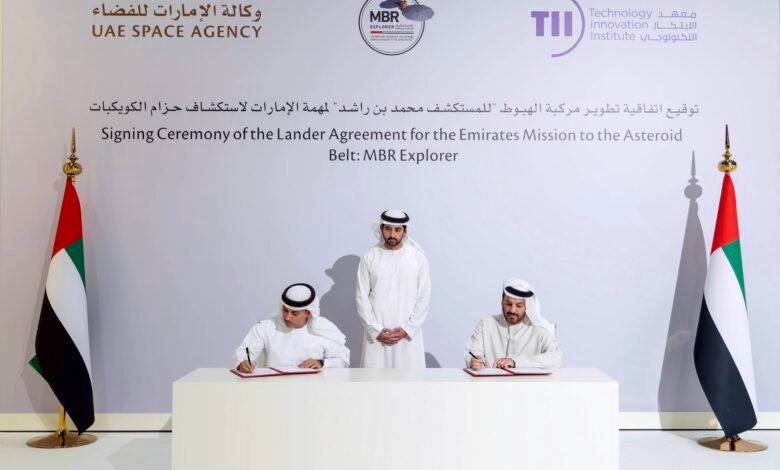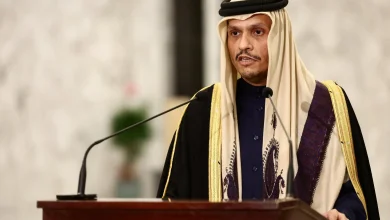
Dubai Crown Prince Oversees Historic Space Lander Agreement
The UAE has launched an extraordinary 13-year space mission that will cover 5 billion kilometers between Mars and Jupiter. Hamdan bin Mohammed witnessed the agreement signing to develop the lander for Emirates Mission to the Asteroid Belt (EMA) on January 9, 2025. This milestone marks a significant step in UAE’s space exploration. The mission aims to conduct detailed flybys of seven asteroids. A specially designed lander will focus on the final asteroid, Justitia. UAE’s space sector shows its strength with a $10.9 billion investment, and private sector companies will handle 50% of the mission. The Technology Innovation Institute (TII) leads the lander’s development. UAE-based companies 971Space and SADEEM Space Solutions collaborate to create opportunities from space exploration challenges for future generations.
UAE’s Strategic Space Milestone
UAE’s space sector has seen remarkable growth, with investments hitting Dhs40bn over the last several years. The sector shows strong momentum with a 29% yearly rise in operating companies and a 14.8% increase in research and development spending.
The nation’s strategic vision has led to several achievements:
- The Arab world’s first Abu Dhabi Quantum Optical Ground Station (ADQOGS)
- Defense-focused quantum communication infrastructure
- Integration of both fiber-based and satellite quantum networks
Private sector funding now drives much of the growth and represents 44.3% of total investments. More than 200 private companies now operate in the Space Economic Zones Program. This shows the sector’s strong commercial potential.
Salem Butti Salem Al Qubaisi, Director General of the UAE Space Agency, highlights the country’s decisive role in global space exploration. The UAE has built strategic collaborations with major international space agencies like NASA, JAXA, Roscosmos, and the Indian Space Agency.
The nation’s steadfast dedication to space excellence grows stronger through partnerships with academic institutions. Collaborations with Khalifa University, New York University Abu Dhabi, and the National Space Science and Technology Center are the foundations of future space initiatives.
Technical Innovation and Development
The MBR Explorer marks a major step forward in UAE’s space technology capabilities. This 2.8-ton spacecraft uses innovative thrusters and moves at an average speed of 33,000 km/h. Engineers specially built it to explore deep space.
The spacecraft’s scientific capabilities show its technical excellence with these instruments:
- High-resolution camera
- Thermal infrared camera
- Mid-wavelength spectrometer
- Infrared spectrometre
The Technology Innovation Institute (TII) leads the lander’s development through collaboration with local startups to boost domestic manufacturing. The project focuses on national participation, with 80 team members working directly on different development aspects.
The technical phase brings together prestigious partners like Khalifa University, New York University Abu Dhabi, and the National Space Science and Technology Center. These strategic collaborations ensure innovative research flows throughout the mission’s development cycle.
UAE Space Agency created a complete Science, Technology, and Innovation (STI) Roadmap to support this ambitious mission. This framework promotes public collaboration and helps turn new ideas into practical space projects. The nation’s competitive edge in space exploration grows stronger as a result.
Mission to Asteroid Belt
March 2028 marks the launch of the Emirates Mission to the Asteroid Belt, a groundbreaking deep space exploration project. The mission will run for 13 years – six years to develop the spacecraft and seven years of actual flight.
The MBR Explorer will travel an incredible 5-billion-kilometer distance through space. It will use gravity-assist maneuvers around Venus, Earth, and Mars to find the best path. The spacecraft will reach its first asteroid in February 2030 and continue with more flybys until 2034.
The mission’s main goals are to:
- Understand how water-rich asteroids formed and evolved
- Study resources that could help future space exploration
- Learn about multiple asteroids’ geological history and volatile content
- Track surface temperatures and physical properties to study their changes
The mission’s final target, asteroid Justitia, stands out as the main asteroid belt’s reddest object. Scientists think its unique red color suggests the presence of water and organic materials on its surface.
The project goes beyond science to set new standards for working together across borders. The UAE Space Agency has built strong partnerships with several organizations. They work closely with the Laboratory for Atmospheric and Space Physics, which helps transfer knowledge. This shared approach will drive the mission’s success and help build UAE’s space exploration capabilities for the future.
UAE’s remarkable progress in space exploration shines through this ambitious asteroid belt mission. The project combines advanced technical breakthroughs with strategic international partnerships that position the UAE as a key player in global space research. The nation shows its steadfast dedication to space sector excellence through a detailed approach that spans scientific findings, technological progress, and commercial growth.
The MBR Explorer mission opens a new chapter in UAE’s space experience. UAE Space Agency has built strong foundations for future space attempts through Dhs40bn worth of strategic investments and collaborations with leading institutions. Scientists expect valuable lessons about our solar system’s history from the mission’s focus on asteroid exploration, especially when you have water-rich Justitia as the target.
UAE’s space capabilities grow stronger through teamwork between government entities, private companies, and academic institutions. This historic mission advances scientific knowledge and creates opportunities for future space scientists and engineers. The mission’s success will revolutionize deep space exploration and cement UAE’s role as a pioneer in astronomical research.





